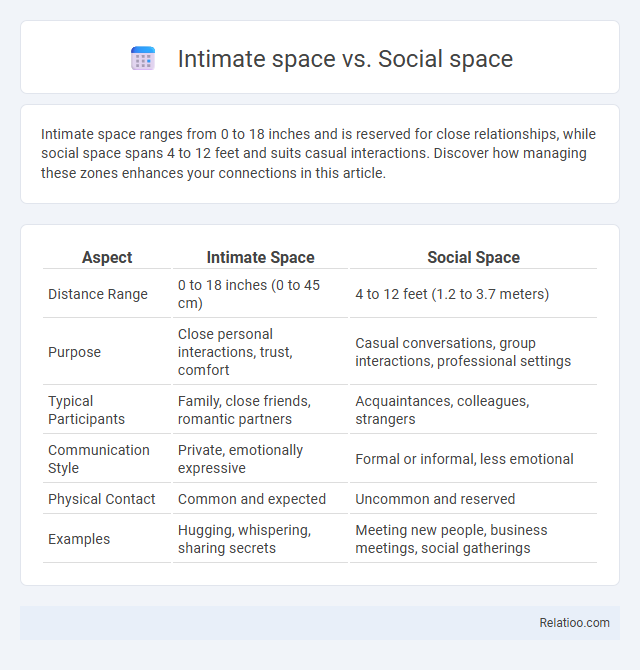Intimate space ranges from 0 to 18 inches and is reserved for close relationships, while social space spans 4 to 12 feet and suits casual interactions. Discover how managing these zones enhances your connections in this article.
Table of Comparison
| Aspect | Intimate Space | Social Space |
|---|---|---|
| Distance Range | 0 to 18 inches (0 to 45 cm) | 4 to 12 feet (1.2 to 3.7 meters) |
| Purpose | Close personal interactions, trust, comfort | Casual conversations, group interactions, professional settings |
| Typical Participants | Family, close friends, romantic partners | Acquaintances, colleagues, strangers |
| Communication Style | Private, emotionally expressive | Formal or informal, less emotional |
| Physical Contact | Common and expected | Uncommon and reserved |
| Examples | Hugging, whispering, sharing secrets | Meeting new people, business meetings, social gatherings |
Understanding Personal Space: An Overview
Understanding personal space involves distinguishing between intimate space, social space, and general space, each defined by specific distance ranges that influence human interaction. Intimate space, typically within 0 to 18 inches, is reserved for close relationships and emotional connection, while social space, ranging from 4 to 12 feet, facilitates casual or professional interactions. Your awareness of these spatial boundaries improves communication and comfort in various social settings, enhancing relationship dynamics and personal well-being.
Defining Intimate Space: What It Means
Intimate space refers to the physical distance typically reserved for close relationships, ranging from skin contact to about 18 inches, where personal interactions occur with trusted individuals such as family, close friends, or romantic partners. Social space extends from 4 to 12 feet and is used for casual or professional interactions, maintaining a comfortable distance for conversations without personal invasion. Understanding these spatial zones is crucial in social psychology and communication studies to navigate interpersonal boundaries effectively and respect personal comfort levels.
Social Space Explained: Boundaries and Expectations
Social space refers to the physical and psychological boundaries maintained between individuals during casual or group interactions, typically ranging from 4 to 12 feet. These boundaries help regulate comfort levels and communication dynamics in social settings, balancing personal space with accessibility. Understanding social space is crucial for respecting expectations in diverse environments such as workplaces, parties, and public gatherings.
The Psychology Behind Spatial Preferences
Understanding the psychology behind spatial preferences reveals how intimate space typically ranges from 0 to 18 inches, allowing for close personal interactions, while social space extends from 4 to 12 feet, facilitating comfortable conversations without intrusion. Your brain instinctively navigates these zones to maintain a sense of safety and trust, influenced by cultural norms and individual personality traits. Awareness of these distinct spatial boundaries enhances communication effectiveness and emotional connection in various social settings.
Cultural Influences on Intimate and Social Space
Cultural influences significantly shape how intimate and social spaces are perceived and navigated, affecting personal boundaries and interaction distances within different societies. In some cultures, close physical proximity in intimate spaces is a sign of warmth and trust, while in others, greater distance is maintained to preserve privacy and respect. Understanding these cultural nuances allows you to communicate effectively and respect others' social norms, fostering better interpersonal relationships across diverse cultural contexts.
Impacts of Technology on Personal Boundaries
Technology has reshaped your intimate space by enabling constant digital connectivity that blurs the lines between private and social environments. Social space boundaries are impacted as online platforms create persistent interactions beyond physical proximity, affecting how individuals negotiate personal limits. This shift challenges traditional notions of space, requiring new strategies to maintain privacy and respect in both virtual and real-world settings.
Navigating Intimate vs Social Space in Relationships
Navigating intimate and social spaces in relationships requires understanding the personal boundaries and comfort levels associated with each zone; intimate space typically ranges up to 18 inches and is reserved for close connections, while social space extends from 4 to 12 feet, accommodating acquaintances and casual interactions. Misreading these spatial cues can lead to discomfort or misunderstandings, making it essential to respect the physical distance preferred in different relational contexts. Effective communication and sensitivity to nonverbal signals help partners negotiate transitions between intimate and social spaces, reinforcing trust and emotional connection.
Consequences of Violating Spatial Boundaries
Violating intimate space, typically reserved for close relationships and measuring about 0 to 18 inches, can cause discomfort, anxiety, and feelings of vulnerability. Social space, ranging from 4 to 12 feet, is used in casual interactions; breaching this boundary often results in perceived aggression or disrespect, negatively impacting your social interactions and trust. Understanding these spatial boundaries is crucial for maintaining positive relationships and avoiding conflicts arising from unintentional invasions.
Tips for Respecting Others' Personal Space
Respecting intimate, social, and personal spaces requires recognizing their distinct boundaries: intimate space spans 0-18 inches, social space 4-12 feet, and general personal space varies by culture and context. Tips include observing body language for discomfort, asking permission before entering closer zones, and maintaining appropriate distance during interactions to foster comfort and trust. Awareness of spatial cues minimizes intrusion, promotes respectful communication, and supports positive social dynamics.
Adapting Personal Space in Different Environments
Adapting personal space in different environments requires understanding the distinctions between intimate space (0-18 inches), social space (4-12 feet), and general space. Intimate space is reserved for close relationships and private interactions, while social space facilitates casual or professional communication in public or workplace settings. Effective adaptation involves recognizing these spatial boundaries to maintain comfort, respect privacy, and enhance social interactions across various cultural and situational contexts.

Infographic: Intimate space vs Social space
 relatioo.com
relatioo.com